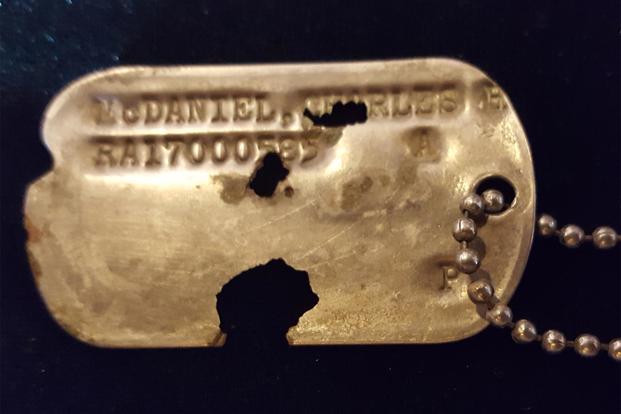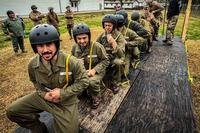The name on the dog tag returned along with the remains of troops missing from the Korean War last week was that of Master Sgt. Charles Hobert McDaniel, an Army medic from Indiana who fell in battle nearly 68 years ago.
"We were just overwhelmed," McDaniel's son, Charles Jr., said Wednesday of the phone call he received from the Army notifying him of the find.
"I have to say, I didn't think about the emotions that were very deep, even though I was a small boy and have very little memory of my father," said the son, who was three years old when his father fell in 1950. "But I sat there and I cried for a while and it took a while to compose myself."
Charles Jr., 71, a retired Army lieutenant colonel and chaplain from Indianapolis, immediately called his brother Larry, 70, in Jacksonville, Florida.
"I was just flabbergasted," Larry McDaniel said, adding that his father was "just one of thousands of guys from that generation who did what they did" and never came home.
The dog tag bearing McDaniel's name, blood type and other information "was the only personal effect" found in the 55 boxes of remains that were brought back to Hawaii on Aug. 1, said Dr. John Byrd, a forensic anthropologist and director of laboratories for the Defense POW/MIA Accounting Agency (DPAA).
Byrd, who led the U.S. team into North Korea on July 27 to receive the 55 transfer cases, joined the McDaniel brothers and DPAA and Army officials for a brief acceptance ceremony in Arlington, Virginia, ahead of meetings Thursday with more than 700 families of troops missing from the Korean War.
McDaniel also served in Europe during World War II with the 83rd Infantry Division, where he earned the Bronze Star with combat "V" device, Charles Jr. said.
In Korea, McDaniel was serving with the Medical Co., 8th Regiment, 1st Cavalry Division, as part of the U.S. Eighth Army in late October 1950. As they approached the Yalu River separating Korea from China, Chinese People's Army forces attacked.
The Americans and Republic of Korea forces were driven back. In a battle near Unsan, about 60 miles north of the North Korean capital of Pyongyang, McDaniel, who was with the 3rd Battalion of the 8th Regiment at the time, went missing.
The DPAA said that an eyewitness -- another medic -- later said he believed McDaniel was killed in action. DPAA officials also said there was no evidence that he was ever captured and held in a prisoner of war camp. McDaniel was 33 years old when he went missing.
According to the DPAA, about 7,700 U.S. service members are still listed as missing in action from the Korean War, about 5,300 of them in what is now North Korea.
Charles Jr. said he and his brother consider themselves among the luckiest of those thousands of families still hoping they will have a chance to welcome their loved ones home.
"We don't know if my father's remains will be found, but at least we have this," he said while holding up the dog tag.
The return of the remains was the result of weeks of haggling with the North Korean side and came amid mistaken claims by U.S. President Donald Trump that repatriations had already occurred following his June 12 Singapore summit with North Korean leader Kim Jong Un.
North Korean military officials were no-shows for an initial meeting on repatriations, but a deal for the return of remains was finally worked out by Air Force Maj. Gen. Michael Minihan, chief of staff of the United Nations Command in Korea, in talks at the Panmunjom peace village on the Demilitarized Zone.
On July 27, Byrd and a U.S. team flew to Wonsan on North Korea's east coast, where they picked up the 55 cases and then flew to Osan Air Base, south of Seoul.
Byrd said the North Koreans did not tell him of the possibility of finding personal effects in the cases. At Osan, Byrd conducted a preliminary review of the contents of the cases and found the dog tag. The McDaniel family was immediately notified, DPAA officials said.
Byrd said the dog tag was individually wrapped in a bag that was included with a separate bag of remains in one of the cases.
On Aug. 1, the 55 cases were flown back to the U.S. aboard two Air Force C-17 Globemasters to Hickam Air Force Base in Hawaii for an "honorable carry" ceremony.
"Our boys are coming home," Vice President Mike Pence, who presided at the ceremony, said.
It’s too early to say how many individuals may be represented by the remains in the 55 cases, Byrd said. In past repatriations, several individuals' remains were represented in one box, he said.
The early indications are that the remains in the 55 cases are those of Americans, and "they are certainly remains that can be looked at and tested," he said.
DNA samples from the remains are to be sent later this month to the Armed Forces DNA Identification Laboratories at Dover Air Force Base in Delaware to begin the process of matching them against the existing DNA database from more than 90 percent of the families of the missing.
Charles Jr. had already given a DNA sample, but his brother had not. To aid in the identification process, Larry McDaniel had his mouth swabbed for a DNA sample right after he and his brother were presented with the dog tag.
-- Richard Sisk can be reached at richard.sisk@military.com.















